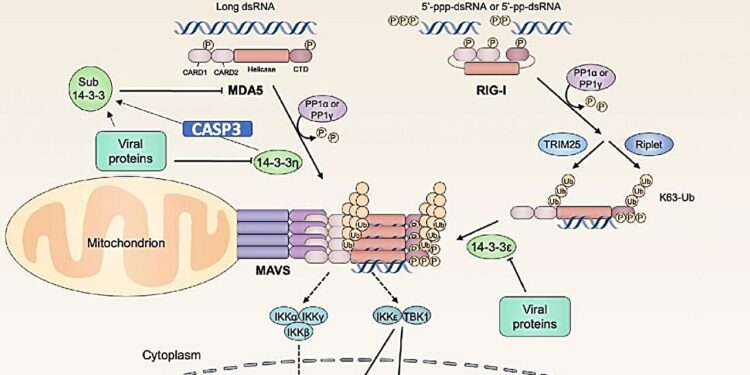Illustration of the proposed model during a viral infection. Credit: National Taiwan University
Scientists at National Taiwan University have made a discovery about a protein named 14-3-3η, revealing its complex role in host defense against RNA viruses.
First, the 14-3-3η protein acts as a key ally in the immune response. It works with another protein called MDA5 to detect and alert the immune system to the presence of RNA viruses. This early warning system is essential for mounting a rapid and effective defense.
But the story doesn’t end there. Under certain circumstances, 14-3-3η can be cleaved by an enzyme called Caspase-3, transforming it into a new form that counteracts its original function. This newly generated version of 14-3-3η can actually inhibit the activity of MDA5, potentially limiting the immune response.
The article is published in the journal PLOS Pathogens.
This dynamic interplay between the two roles of the 14-3-3η gene is essential to maintaining a delicate balance. The host must be able to fight infections effectively, but it must also prevent excessive inflammation, which can be harmful. The 14-3-3η gene helps regulate this process, ensuring an appropriate and controlled immune response.
Unfortunately, some RNA viruses have developed strategies to exploit the dual nature of the 14-3-3η gene. They can manipulate the body’s signaling pathways to favor the production of the inhibitory form of the 14-3-3η gene, allowing them to evade detection and potentially initiate infection.
This new understanding of the role of 14-3-3η in viral infections opens up interesting therapeutic possibilities. In conclusion, the discovery of the dual role of 14-3-3η in the immune response against RNA viruses provides valuable insights into the complex interaction between the host and the pathogen.
By targeting the mechanisms that regulate 14-3-3η, researchers may be able to develop new strategies to enhance the immune response against RNA viruses. Additionally, understanding how viruses manipulate 14-3-3η could lead to the development of antiviral agents that disrupt these viral tactics.
More information:
Yun-Jui Chan et al, Temporal regulation of MDA5 inactivation by caspase-3-dependent cleavage of 14-3-3η, PLOS Pathogens (2024). DOI: 10.1371/journal.ppat.1012287
Provided by National Taiwan University
Quote:The Good, the Bad, and the Split: 14-3-3η in Viral Battles (2024, August 29) Retrieved August 29, 2024 from
This document is subject to copyright. Apart from any fair dealing for the purpose of private study or research, no part may be reproduced without written permission. The content is provided for informational purposes only.



